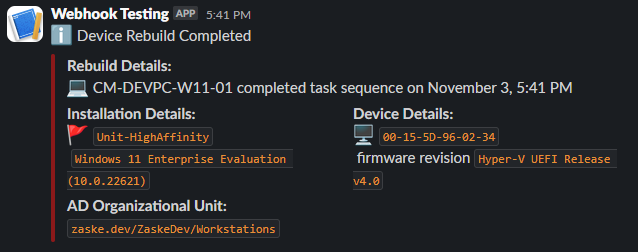
UPDATE: Direct Slack Notification From a Task Sequence Step
- Matt Zaske
- November 04, 2024
- 4 minutes
Last week I wrote about a basic process I have in place to fire off a Slack notification when a Task Sequence completes. As I wrapped up that post, I'd mentioned how it would be feasible to directly fire off the notification via webhook from a Powershell step in the Task Sequence by modifying a few arguments to Invoke-RestMethod and generating the Slack block bits in Powershell instead of PHP.
I had some time this past week and decided to give it a go. And it was (more or less) as "simple" as I'd expected!
It's Lightweight
The direct method has several fewer moving parts and is still invoked via a Run PowerShell Script step in the TS. For my own testing purposes, I use the embedded script type:

The Script Itself
The script isn't fundamentally different than the PHP variant TSCompleteNotifier.php. The most complicated difference is in how the Block structure itself is curated due to how the JSON payload must be provided. This means a combination of Powershell arrays and hashtables, and took the most fiddling of it all to get the proper structure (see the $blockFields and $attachments variables below).
$deviceName = hostname
$slackWebhookURL = 'https://hooks.slack.com/you/generated/when/setting/up';
$formattedDateTime = (Get-Date).ToString("MMMM d, h:mm tt")
# Task Sequence Variables
$tsenv = New-Object -COMObject Microsoft.SMS.TSEnvironment
# These variables are globally available
$MACAddress = (Get-NetAdapter | Where-Object Status -eq "Up").MacAddress
$OSInfo = (Get-ComputerInfo | Select-Object OsName, OsVersion)
$OSData = ($OSInfo.OsName -replace "Microsoft ", "") + " (" + $OSInfo.OsVersion + ")"
if ($MACAddress.Count -gt 1) {
$MAC = $MACAddress[0]
} else {
$MAC = $MACAddress
}
# These variables are custom and will be empty unless your TS declares/sets them
$InstallType = $tsenv.Value("InstallType")
$OSDOUCN = $tsenv.Value("OSDOUCN")
$FirmwareRev = $tsenv.Value("OSDDeviceFirmwareVersion")
# Variables containing the bits to submit in the Slack webhook
$channel = '#quiet-private-channel-name-goes-here';
$bot_name = 'Device Rebuild Completed';
$icon = ':information_source:';
$message = '';
$blockMessage = ":computer: $deviceName completed task sequence on $formattedDateTime";
# Create the block fields for data points (array of hashtables)
$blockFields = @(
@{
title = 'Rebuild Details:'
value = $blockMessage
short = $false
}
@{
title = 'Installation Details:'
value = ":triangular_flag_on_post: ``$InstallType``
``$OSData``"
short = $true
}
@{
title = 'Device Details:'
value = ":desktop_computer: ``$MAC``
firmware revision ``$FirmwareRev``"
short = $true
}
@{
title = 'AD Organizational Unit:'
value = "``$OSDOUCN``"
short = $false
}
)
# Create the attachments payload
$attachments = @(
@{
fallback = "Device rebuild detected: $deviceName completed task sequence on $formattedDateTime"
pretext = ':information_source: Device Rebuild Completed'
color = '#8c1919'
fields = $blockFields
}
)
# Create the actual webhook data payload
$data = @{
channel = $channel
username = $bot_name
text = $message
icon_emoji = $icon
attachments = $attachments
}
# Convert the payload to JSON (recursively)
$data_string = $data | ConvertTo-Json -Depth 4
# Create Headers
$headers = New-Object "System.Collections.Generic.Dictionary[[String],[String]]"
$headers.Add("Content-Type", "application/json")
$headers.Add("Content-Length", $data_string.Length)
# Parameter Hashtable
$Params = @{
Uri = $slackWebhookURL
Method = "Post"
Headers = $headers
Body = $data_string
}
# Submit!
$response = Invoke-RestMethod @Params
$response | ConvertTo-JsonAn interesting side note about this script is that I needed to provide the -Depth argument for ConvertTo-Json in creating the $data_string declaration, otherwise the output JSON wouldn't be properly formatted. This was a bit surprising to me coming from PHP land where json_encode handles it all automatically, but wasn't terribly surprising given the complex Block structure (and thus array/hashtable bits).
The Result
It works great directly from Powershell!

The Repo
I have updated the starter repo with additional documentation and the "Direct" script that can be used in lieu of the multi-step process. Hopefully this combination of posts and some starter code is helpful/useful for your own case! Good luck!






